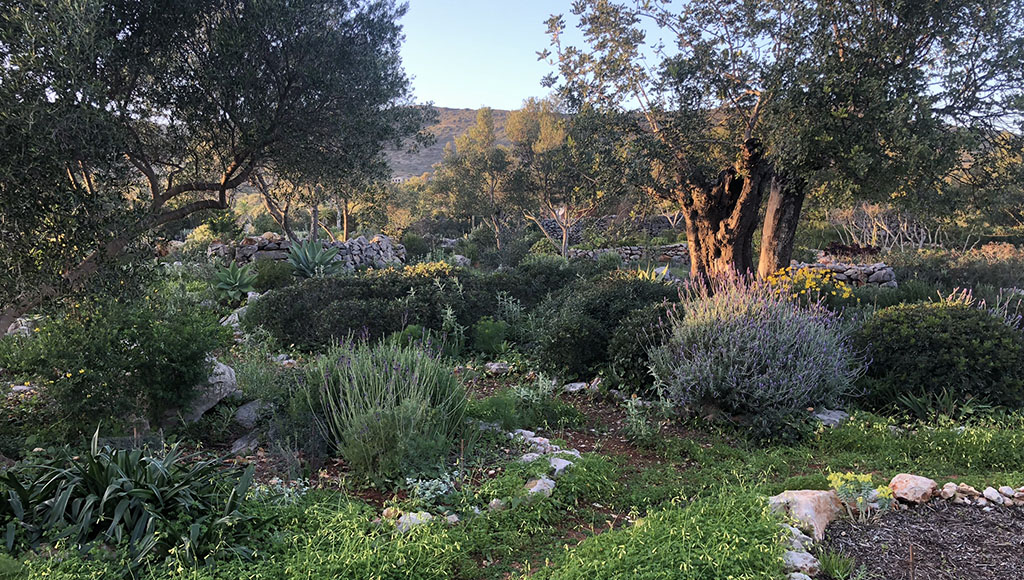As we enter the summer months with the prospect of the longest day coming up fast on June 21, we can observe how the change of seasons brings new colours and shapes into a natural dry garden.
In the course of their evolution, the plants of mediterranean climate zones have developed a range of remarkable strategies to cope with dry conditions. Gardeners can learn a lot from studying these strategies, gaining a better understanding of how to plant and maintain dry climate plants.
This allows us to make the most of their various survival techniques in creating a natural, beautiful, sustainable mediterranean garden with minimum workload.

These strategies include the very simple method of avoiding the heat by disappearing below the ground. Annual plants grow, flower and set seed during the cooler, more humid months and the seed awaits the next rainy season to emerge and start a new life cycle with spectacular spring flower displays for our gardens.
The classic disappearing act is performed by the geophytes – bulbs, corms and rhizomes. During their growth cycle, nutrients and water are gathered by the leaves and stored in the subterranean structures. The first rains of autumn give the signal for regrowth and bulbs such as Sternbergia lutea can emerge in a predictable 10 days following the first rains.

Photo: Olivier Filippi
Most shrubs and sub-shrubs of dry climate zones have developed two root systems. A more shallow set of surface roots will take advantage of any small rainfall amounts. Before this, the plant will send down a long moisture seeking tap root system in order to ensure survival through the first and subsequent long hot summers.
Some plants in desert situations can send their roots as far as 10m below the surface. This explains why so many native and dry climate plants do not thrive in pots, and also why it is important to buy smaller plants when making your dry climate garden.
Another important adaptation is the reduction of transpiration by means of a hard waxy coating on leaf surfaces. Sclerophyllus plants reduce water loss by only having stoma on the underside of their leaves, the side most protected from the sun. This includes common Algarve plants such as holm oak, lentisk, myrtle, phillyrea and arbutus.
Summer dormancy is common in mediterranean climate zones, the complete opposite of the growing season in northern temperate zones. Indeed, watering some plants in the summer months can promote fungal rot and kill many lovely dry climate plants such as lavender, cistus and phlomis. Autumn planting is the general rule and is the starting point of the natural growth cycle for these plants adapted to long, hot summers.

There are also plants which will control water loss by dropping all their leaves. This can provide spectacular ‘autumn’ colours during late May and early June. The classic dry climate plant Euphorbia dendroides (tree spurge) gives brilliant red colour to French Riviera hillsides and is a very successful plant in Algarve gardens.
Another method of protecting leaf surfaces happens when the leaves turn up to form chimneys with their silver and often very hairy undersides folding round one another in columns. Phlomis purpurea and some cistus do this. The whole colour of the plant changes from green to silver as the leaves roll upwards.

Mediterranean plants include some of the most popular aromatic herbs. The production of oil is another method by which the plant will seek to reduce water loss by the cooling effect around the plant. A layer of strongly aromatic leaves will also reduce competition and grazing.
Succulents are a well-known plant choice for dry climate gardens. Their swollen stems and branches are filled with large cells creating a sponge-like structure for water storage. The native plants of Portugal include Sedum sediforme, most often seen growing in dry stone walls and in flower at the moment. You can see the cream-coloured heads swaying above the rosettes securely fixed between rocks and stones in a habitat which looks far from inviting on a hot day.
The natural form for many mediterranean plants is to become rounded, accepting light from all directions but shading the roots, cooling the soil and internal stem structure. This natural habit can be used to great advantage in a garden. Maintenance is reduced to an annual trim removing old flower heads and shaping ahead of the next autumnal growth cycle.
Do not be concerned if your plants look dead, they are merely sleeping and waiting for the rain!
With grateful thanks to Olivier Filippi – The Dry Gardening Handbook – Plants and Practices for a Changing Climate (available from the bookshop www.mgaportugal.org)
By Rosie Peddle
|| features@algarveresident.com
289 791 869 | mgapsec@gmail.com
facebook.com/MedGardenersPortugal
www.mgaportugal.org




















